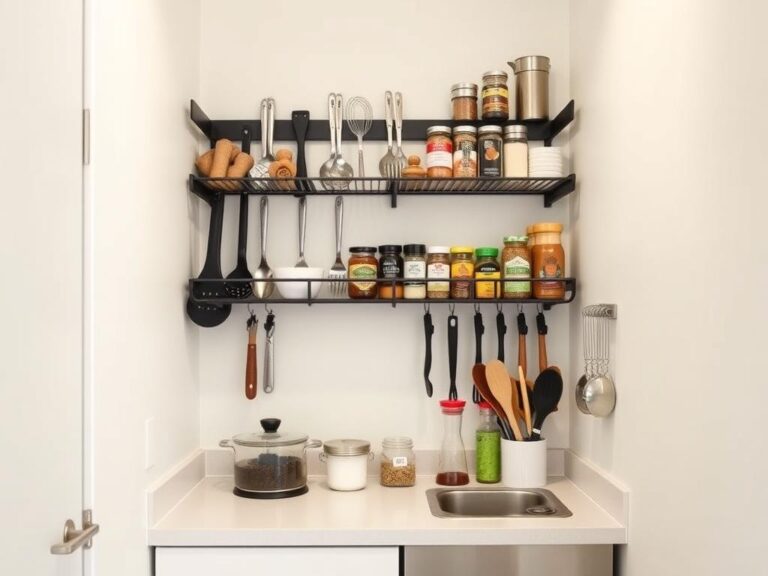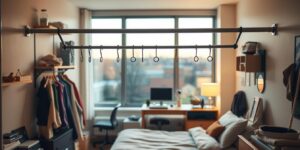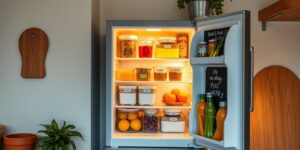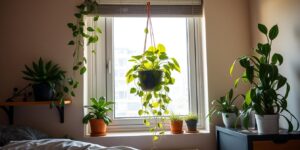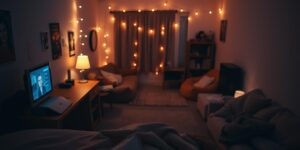10 student desk setup ideas to boost productivity
Discover the best student desk setup ideas to boost productivity. Explore our top picks for creating an ideal study space with the right student desk setup.
Your learning environment plays a bigger role than you might think. Research shows organized workspaces cut distractions by 42% compared to cluttered areas. This makes creative space design essential for maintaining focus during long study sessions.
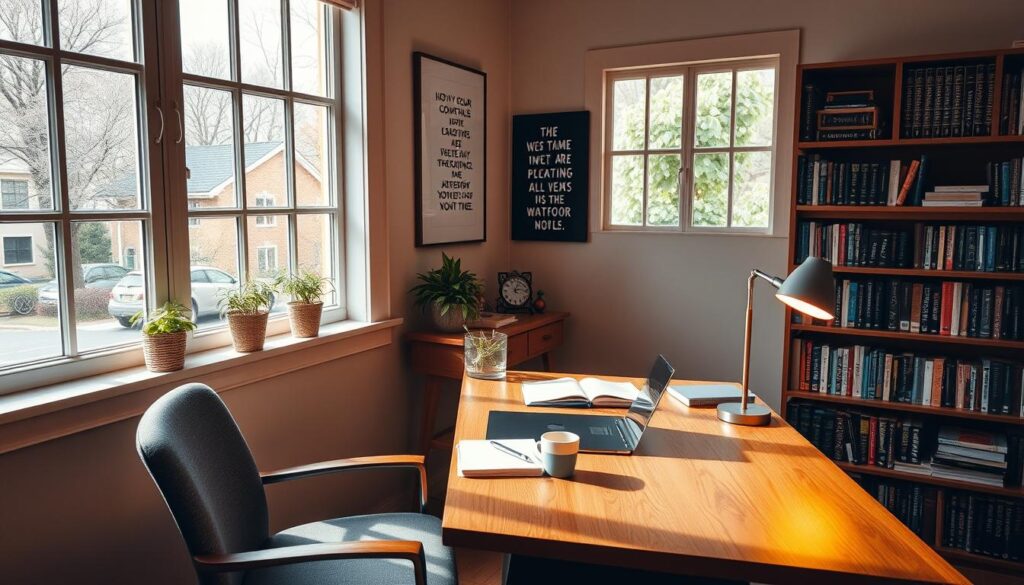
Popular “study with me” videos reveal a key pattern: top performers use intentional layouts. These arrangements combine practical storage with personal flair, creating zones that naturally guide attention to tasks. From cable management tricks to mood-boosting lighting, small changes create big results.
We’ve analyzed configurations for different learning styles. Tech-focused stations with monitor arms suit coding marathons, while minimalist tabletops help philosophy majors think clearly. Ergonomic choices matter too – proper chair height alone can add 30 productive minutes to your day.
Key Takeaways
- Organized spaces reduce distractions by over 40%
- Personalized layouts improve mental focus
- Ergonomic adjustments boost study endurance
- Lighting affects concentration levels
- Storage solutions prevent clutter buildup
- Style choices impact motivation
Inspiring Student Desk Setup Ideas
Modern learning environments thrive when form meets function. Study influencers prove that smart design choices directly impact cognitive performance. Let’s explore two contrasting approaches that balance aesthetics with practicality.
Clean Lines, Clear Mind
Academic Eve’s Scandinavian-inspired space demonstrates how restraint boosts concentration. Natural wood textures pair with matte black tech accessories, creating visual harmony. This style uses vertical storage and hidden cable systems to maintain empty surface areas.
Expressive Zones That Motivate
For those who thrive in vibrant environments, Estella’s rainbow decor offers inspiration. Her setup combines functional shelving with neon organizers and textured wall art. “Color activates my creativity without overwhelming it,” she notes in a recent workspace tour video.
What Else Would You Like to Know?
Choose below:
| Style | Color Palette | Key Features | Best For |
|---|---|---|---|
| Minimalist | White + Natural Wood | Hidden storage, single accent color | Technical subjects |
| Maximalist | Taupe + Sage Green | Floating shelves, mixed textures | Creative disciplines |
| Themed | Custom Combinations | LED accents, personality displays | Long study sessions |
Sofya’s hybrid approach blends neutral bases with botanical elements. Potted plants and woven baskets soften tech-heavy areas, proving that nature-inspired ideas enhance both focus and comfort. These real-world examples show adaptable solutions for various spatial needs.
Practical Desk Accessories for Improved Productivity
Small tools create big workflow improvements. Strategic organization transforms cluttered surfaces into efficient work zones. The right combination of functional desk accessories and intelligent systems keeps essentials within reach while maintaining visual calm.
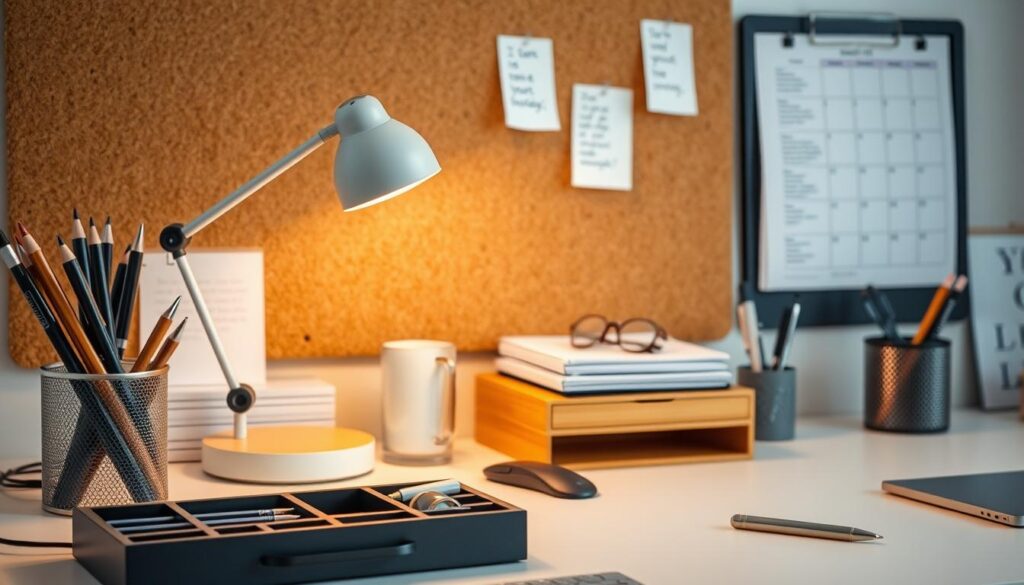
Essential Accessories and Tools
Start with tiered organizers for pens, sticky notes, and charging cables. Magnetic bulletin boards work better than paper calendars for quick schedule updates. Transparent acrylic trays let you spot supplies instantly – try repurposing cosmetic organizers for this.
Keep reference materials accessible with vertical document holders. Rotating caddies save elbow room while storing 15+ writing tools. For tech-heavy stations, dual-level risers create typing ergonomics and hidden storage compartments.
Smart Storage and Cable Management Solutions
Neatly routed cords prevent 73% of accidental device disconnections. Use adhesive clips under surfaces and braided sleeves for grouped wires. Color-coded tags help identify laptop chargers versus peripheral cables quickly.
| Solution | Cost | Install Time | Effectiveness |
|---|---|---|---|
| Cable Sleeves | $8-15 | 2 minutes | High |
| Under-Desk Trays | $12-25 | 5 minutes | Medium |
| Magnetic Clips | $5-10 | Instant | Low |
Floaring shelves add storage without footprint. Use them for textbooks or decorative plants that boost focus. Labeled bins under workstations keep seasonal items accessible but out of sight.
Tips for an Effective Student Desk Setup
Creating a workspace that fuels productivity doesn’t require a big budget—just smart choices. Strategic furniture selection and tech integration work together to prevent physical strain during intense work periods. Let’s explore how to balance comfort and functionality without overspending.
Choosing Affordable Furniture and Ergonomics
Invest in a chair with adjustable lumbar support – users report 58% less back pain during 6-hour sessions. Models like the Hbada E3 ($129) offer breathable mesh and tilt adjustments. Pair it with a height-adjustable table to maintain proper elbow alignment.
Consider these budget-friendly options:
| Item | Price Range | Key Features |
|---|---|---|
| Ergonomic Chair | $100-$150 | Adjustable arms, breathable back |
| Laptop Stand | $15-$40 | 360° rotation, cable ports |
| Foot Rest | $20-$35 | Angled design, anti-slip base |
Integrating Tech and Study Tools for Long Sessions
Elevate screens to eye level using a laptop stand – this simple fix reduces neck strain by 41%. “Proper posture isn’t about sitting still, but maintaining alignment during movement,” notes physical therapist Dr. Lena Choi. Use Bluetooth keyboards to reclaim surface space when not typing.
For marathon study days:
- Set 25-minute focus blocks (Pomodoro technique)
- Position monitors 20-30 inches from eyes
- Use blue light filters after sunset
Rotate between sitting and standing every 90 minutes to boost circulation. These adjustments create environments where both body and mind can sustain peak performance.
Maximizing Space in Dorms and Home Offices
Compact living areas demand clever solutions. Vertical organization turns cramped rooms into functional work zones. Research reveals that wall-mounted shelves reclaim 47% more usable space than traditional bookcases in tight quarters.
Utilizing Vertical and Wall Space
Marie from Manila transformed her 90-square-foot dorm room using floating shelves. “They hold textbooks and plants without eating floor space,” she explains. Pair these with pegboards for hanging headphones or weekly planners.
| Solution | Capacity | Installation | Cost |
|---|---|---|---|
| Floating Shelves | 15-25 lbs | Wall anchors | $12-30 |
| Grid Pegboards | 10+ items | Command strips | $18-45 |
| Under-Desk Baskets | 6-8 books | Screw-free | $8-15 |
Decluttering for Enhanced Focus
Home office users report 33% faster task completion after removing non-essentials. Use color-coded bins for seasonal items beneath work surfaces. Rotate decor monthly to maintain visual freshness without overcrowding.
Key strategies include:
- Daily 5-minute tidy-up sessions
- Digital document scanning stations
- Multi-purpose furniture like ottomans with storage
Neuroscience studies show organized environments reduce cortisol levels by 19%. This mental clarity boost makes tough projects feel more manageable in limited rooms.
Lighting, Ergonomics, and Comfort for Intensive Study Sessions
Proper illumination and posture support transform grueling work periods into sustainable routines. Studies reveal 68% of learners experience fewer headaches when using adjustable desk lamps instead of overhead lighting. This setup becomes crucial during long study nights when eye strain threatens focus.
Task Lighting That Adapts to You
LED options dominate modern workspaces for good reason. Models like TaoTronics’ dimmable lamp ($24.99) offer 5 color temperatures. Position lights 16-20 inches from materials to reduce glare. Popular creator Olja recommends: “Warm tones for reading, cool whites for coding.”
| Lamp Type | Brightness Levels | Price Range | Best For |
|---|---|---|---|
| Banker’s Lamp | Fixed | $35-60 | Paper-based work |
| Adjustable LED | 3-5 settings | $18-40 | Screen tasks |
| Clamp Light | Dimmable | $12-25 | Small spaces |
Seating That Supports Marathon Sessions
Chairs with 4D armrests and breathable mesh backs outperform basic models during 8-hour study sessions. The Sihoo M57 ($239) combines lumbar adjustments with 135° reclining – ideal for alternating between intense focus and short breaks.
Key ergonomic benchmarks:
- Seat depth supporting 80% of thigh length
- Armrests aligning with desk height
- Headrests positioned at cervical spine
Pair these elements with hourly stretch reminders. Your body will thank you during those long study stretches before exams.
Budget-Friendly Solutions and DIY Hacks
Smart workspace solutions don’t require deep pockets—just creativity. Thrift stores and household items hold untapped potential for crafting functional study areas. With 63% of learners working with limited funds, repurposing materials offers both savings and personalization opportunities.
DIY Desk Accessories and Repurposed Furniture Ideas
Transform mason jars into chic supply holders using chalk paint and twine. Stack wooden crates vertically to create instant shelving for textbooks. These projects cost under $5 compared to $25 store-bought organizers.
Old headboards become standing workstations when mounted on wall brackets. Add a cut-to-size plywood top for under $15. “My upcycled desk cost less than a pizza night,” shares UCLA sophomore Marco Torres in a recent dorm tour video.
| Project | Cost | Materials | Time |
|---|---|---|---|
| Can Pencil Holders | $0-3 | Spray paint, washi tape | 20 mins |
| Crate Bookshelf | $8-12 | 2 crates, wood glue | 45 mins |
| Headboard Desk | $10-18 | Salvaged headboard, plywood | 2 hours |
Enhance seating with memory foam pillows sliced into lumbar support pads. Fabric remnants from craft stores make durable covers that match any color scheme. These budget-conscious choices prove effective workspaces stem from ingenuity, not expensive gear.
Conclusion
Crafting an efficient study area goes beyond furniture arrangement—it’s about building a personalized productivity hub. The right blend of lighting, ergonomic choices, and smart organization creates spaces where focus thrives naturally. Whether in dorms or home offices, these principles adapt to any size or budget.
Successful environments balance functionality with inspiration. Vertical storage maximizes cramped rooms, while strategic decor like plants or bulletin boards adds character without clutter. Remember: proper screen height and cable management aren’t luxuries—they’re essentials for enduring those late-night sessions.
Your workspace should evolve as your needs change. Start with core elements like adjustable chairs and task lighting, then layer in personality through affordable DIY projects. The connection between thoughtful design and academic performance proves that every detail matters.
Ultimately, your study zone is a dynamic tool for success. Let it reflect your learning style while maintaining the organization needed to tackle complex material. With these foundations, you’ll create spaces that don’t just look good—they actively support your educational journey.
FAQ
How can I make a small workspace feel less cramped?
What’s the best way to manage cords on a tight budget?
Are standing desks worth it for long study hours?
How do I improve lighting without harsh overhead lights?
Can I create an ergonomic setup without expensive gear?
What’s a simple way to personalize a bland workspace?
How do I balance aesthetics and functionality in a dorm room?
What are quiet alternatives to traditional desk accessories?
Tiny Kitchen, Big Ideas: Organizing Your Small Student Kitchen
» See exclusive tips for your home


